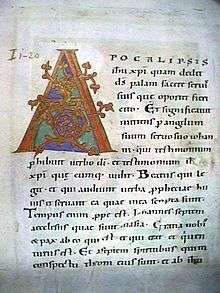Seven Spirits of God

In the Christian Bible, the term Seven Spirits of God appears four times in the Book of Revelation.[1][2] The meaning of this term has been interpreted in multiple ways.[3]
Biblical references
The seven Spirits of God are mentioned four times in the Book of Revelation, and in the book of Isaiah it names each Spirit.[1][2]
- Revelation 1:4 - John to the seven churches which are in Asia: Grace be unto you, and peace, from him which is, and which was, and which is to come; and from the seven Spirits which are before his throne;
- Revelation 3:1 - And unto the angel of the church in Sardis write; These things saith he that hath the seven Spirits of God, and the seven stars; I know thy works, that thou hast a name that thou livest, and art dead.
- Revelation 4:5 - And out of the throne proceeded lightnings and thunderings and voices: and there were seven lamps of fire burning before the throne, which are the seven Spirits of God.
- Revelation 5:6 - And I beheld, and, lo, in the midst of the throne and of the four beasts, and in the midst of the elders, stood a Lamb as it had been slain, having seven horns and seven eyes, which are the seven Spirits of God sent forth into all the earth.
Interpretations
The Sevenfold Ministry of the Spirit
In one interpretation, the "Seven Spirits" represent the sevenfold ministry of the Spirit as depicted in the Book of Isaiah. As it is written: "The Spirit of the LORD shall rest upon him, the Spirit of wisdom and understanding, the Spirit of counsel and might, the Spirit of knowledge and of the fear of the LORD, and He will delight in the fear of the Lord." Isaiah 11:2-3 (NASB). Including the Spirit of the Lord, and the Spirits of wisdom, of understanding, of counsel, of might, of knowledge and of fear of the LORD, here are represented the seven Spirits, which are before the throne of God.[4] The reference to the lamb in Revelation 5:6 relates it to the Seven Spirits which first appear in Revelation 1:4 and are associated with Jesus who holds them along with seven stars.[5]
An alternative view is that the seven graces ("charisma") of Romans 12:6-8 reflect the seven spirits of God. The Holy Spirit manifests in humankind through these graces, reflecting the seven spirits of Yahweh. The seven graces are: 1) insight (prophecy); 2) helpfulness (service or ministry); 3) instruction (teaching); 4) encouragement; 5) generosity (giving); 6) guidance (leadership); and 7) compassion. This agrees with Isaiah 11:2-3 if "the Spirit of the Lord" is recognized as categorical and "the delight in the fear of the Lord" is added.
Seven Distinct Spiritual Beings
In the New Testament, the Greek term "Dynamis" (translated by some as "Virtues") suggests a class of exalted spiritual beings; perhaps parallel to the "chief Princes" (Sar rishown) in the Old Testament, of which the Archangel Michael is stated to be one (Daniel 10:13).[6] "Dynamis" is used by the Apostle Paul to refer to spiritual beings in Romans 8:38; Ephesians 1:21, 3:10, 6:12; and Colossians 1:16, 2:10 & 15. "Powers and principalities" can apply to both angelic and demonic beings, but more often in the New Testament to demonic beings. However, it should be noted, most modern Protestant translators take "Dynamis" to mean 'strength', 'power' or 'ability', whereas the ancient and modern Catholic conception of activity or power was often understood as 'virtues'.
Symbolic of Perfection
Sevenfold may also be connected with the Biblical understanding of the number 7 representing perfection. The "Seven Fold Spirit of God" could be the "perfect" Spirit of God, the Holy Spirit.[7]
Symbolic of Light
Visible light consists of seven primary colors. Flames cast light, and so do stars. Stars are flaming balls of gas/plasma in space, which is "the deep". The Word spoke "Let there be light!" Thus it very well may be that the seven spirits of God are the primary colors of the light of God in the world, which is perhaps why the symbol which God gives Noah after the flood is a rainbow. This is further alluded to in the nature of Jesus, who is said to be "the way, the truth, and the life".
See also
- Christian eschatology
- Holy Spirit (Christianity)
- Seven Archangels
- Seven Churches of Asia
- Water of Life (Christianity)
References
| Wikisource has original text related to this article: |
| Wikisource has original text related to this article: |
- 1 2 The Book of Revelation by Robert H. Mounce 1997 Eerdmans Pub. ISBN 0-8028-2537-0 pages 46-47
- 1 2 Revelation 1-11 by John F. MacArthur (Apr 15, 1999) ISBN 0-8024-0773-0 pages 108, 151, 168
- ↑ Revelation by Craig S. Keener 2000 Zondervan ISBN 0-310-23192-2 Section 1:4
- ↑ Revelation (New Cambridge Bible Commentary) by Ben Witherington (Sep 15, 2003) ISBN 0-521-00068-8 page 75
- ↑ New Testament Theology by Thomas R. Schreiner 2008 Baker Academic ISBN 0-8010-2680-6 page 502
- ↑ Thomas B. White, The Believer's Guide to Spiritual Warfare, page 54 (Regal, 2011). ISBN 978-0-8307-5725-1
- ↑ Matthew Henry’s Concise Commentary Revelations 1:4